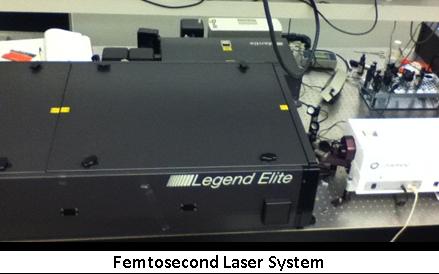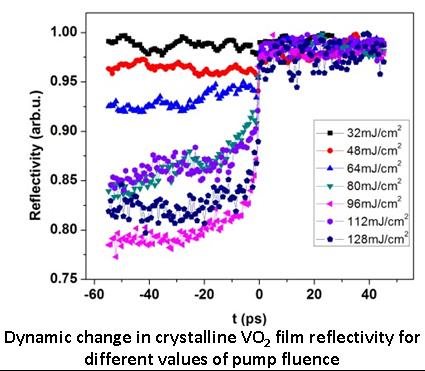Ultrafast dynamics of phase transition in Vanadium Dioxide thin films
 There is a class of materials that undergo an insulator metal transition when heated past a critical temperature. We are working with VO2, which has a phase transition from insulator to metal when heated up to 68oC, making it easy to transition from room temperature. For example, such class of materials is attractive for creating smart windows that change their reflectivity depending on outside temperature. Previous work has shown that the insulator to metal transition (IMT) can also be induced with a pulsed laser beam, on the time scales faster than what can be explained by a thermal transition. Using a femtosecond laser system, we can look at the IMT of a VO2 thin film sample over time.
There is a class of materials that undergo an insulator metal transition when heated past a critical temperature. We are working with VO2, which has a phase transition from insulator to metal when heated up to 68oC, making it easy to transition from room temperature. For example, such class of materials is attractive for creating smart windows that change their reflectivity depending on outside temperature. Previous work has shown that the insulator to metal transition (IMT) can also be induced with a pulsed laser beam, on the time scales faster than what can be explained by a thermal transition. Using a femtosecond laser system, we can look at the IMT of a VO2 thin film sample over time.
 For this experiments we use a powerful ultrafast laser system (Mantis + Legend Elite amplifier, Coherent, Inc.) that outputs 100 fs pulses at 785 nm central wavelength. The output of the laser is sent through a beam splitter and sent down two paths. The weaker beam (probe) bounces off a retroreflector that is mounted on a motorized adjustable track, so as to control the time delay between the two beams. Both beams are focused to hit the sample, where we measure the reflectivity of the probe beam. By changing the delay of the probe beam we can see how the reflectivity of VO2 changes over time during the transition. We know from previous study that when VO2 makes the transition from the insulator phase to the metal phase it reflects less of an 800nm beam. We have been able to see the reflectivity drop sharply after the pump beam hits the sample. These measurements allowed us better understand the dependence of induced transition on optical power and sample temperature. We also studied the effect of thermal exchange with the substrait material and how it affects the transition dynamics.
For this experiments we use a powerful ultrafast laser system (Mantis + Legend Elite amplifier, Coherent, Inc.) that outputs 100 fs pulses at 785 nm central wavelength. The output of the laser is sent through a beam splitter and sent down two paths. The weaker beam (probe) bounces off a retroreflector that is mounted on a motorized adjustable track, so as to control the time delay between the two beams. Both beams are focused to hit the sample, where we measure the reflectivity of the probe beam. By changing the delay of the probe beam we can see how the reflectivity of VO2 changes over time during the transition. We know from previous study that when VO2 makes the transition from the insulator phase to the metal phase it reflects less of an 800nm beam. We have been able to see the reflectivity drop sharply after the pump beam hits the sample. These measurements allowed us better understand the dependence of induced transition on optical power and sample temperature. We also studied the effect of thermal exchange with the substrait material and how it affects the transition dynamics.
In the later studies we considered applications of VO2 for development of new UV detectors. Цe demonstrated that VO2/TiO2:Nb thin films display strong photoelectric effect in blue and UV spectral range, making them promising candidates for UV photodetectors. Here we demonstrate further improvement in their performance by adding a noble metal (Au) thin film contacts that alter the electronic structure and carrier density at the VO2/TiO2:Nb interface. These alterations lead to an order of magnitude improvements in relevant parameters such as responsivity, external quantum efficiency, detectivity, and dark current density of the VO2/TiO2:Nb. In addition, the effects of Au contact on the VO2 electronic structure results in substantial changes in electrical properties of VO2 in both insulator and metallic states, and increases the change in resistivity between these two states by at least an order of magnitude. Such demonstrated substantial improvements to the detective and emissive properties of VO2 suggest that addition of a noble metal contacts will not only provide convenient architecture for a photodiode design, but will also lead to superior photodetector performance.
Relevant publications
- Scott E. Madaras, Jason A. Creeden, David J. Lahneman, Aiden Harbick, Douglas B. Beringer, M. Mumtaz Qazilbash, Irina Novikova, and Rosa A. Lukaszew, “Dynamics of the blue pump-induced insulator-to-metal transition and relaxation in VO2/TiO2 and VO2/TiO2:Nb thin films,” Opt. Mater. Express 10, 1393-1404 (2020).
- Jason A. Creeden, Scott E. Madaras, Douglas B. Beringer, Irina Novikova, and Rosa A. Lukaszew, “Growth and Characterization of Vanadium Dioxide/Niobium Doped Titanium Dioxide Heterostructures for Ultraviolet Detection,” Adv. Optical Mater. 1901143 (2019).
- Jason Creeden, Scott Madaras, Douglas Beringer, Irina Novikova, and Rosa Alejandra Lukaszew, “Intrinsic Anomalous Scaling of Epitaxial Vanadium Dioxide Thin Films on Titanium Dioxide,” AIP Advances 9, 095045 (2019).
- S. E. Madaras, J. Creeden, S. Kittiwatanakul, J. Lu, I. Novikova, and R. A. Lukaszew, “ Insulator to metal transition induced by surface plasmon polaritons in VO2/Au thin films,” Optics Express 26, 25657-25666(2018).
- M. Rodriguez-Vega, M. T. Simons, E. Radue, S. Kittiwatanakul, J. Lu, S. A. Wolf, R. A. Lukaszew, I. Novikova, and E. Rossi, “Effect of inhomogeneties and substrate on the dynamics of the metal-insulator transition in VO2 thin films,” Physical Review B 92, 115420 (2015).
- E. Radue, L. Wang, S.Kittiwatanakul, J. Lu, S.A. Wolf, E. Rossi, R.A. Lukaszew, I. Novikova, "Substrate-induced microstructure effects on the dynamics of the photo-induced Metal-insulator transition in VO2 thin films" Journal of Optics 17, 025503 (2015).
- L. Wang, I. Novikova, J. M. Klopf, S. Madaras, E. Madaras, G. P. Williams, J. Lu, S. Wolf and R. A. Lukaszew, "Distinct Length Scales in the VO2 Metal-Insulator Transition Revealed by Bi-chromatic Optical Probing," Advanced Optical Materials 2, 30-33 (2014).
- E. Radue, E. Crisman, L. Wang, S. Kittiwatanakul, J. Lu, S. A. Wolf, R. Wincheski, R. A. Lukaszew, I. Novikova, "Substrate Effect on Optical Properties of Insulator-Metal Transition in VO2 Thin Films," J. Appl. Phys. 113, 233104 (2013).
- L. Wang, E. Radue, S. Kittiwatanaku, C. Clavero,J. Lu, S. A. Wolf, I. Novikova, and R. A. Lukaszew, ""Surface plasmon polaritons in VO2 thin films for tunable low-loss plasmonic applications," Optics Letters 37, 4335-4337 (2012).
- L. Wang, C. Clavero, K. Yang, E. Radue, M. T. Simons, I. Novikova, and R. A. Lukaszew, "Bulk and surface plasmon polariton excitation in RuO2 for low-loss plasmonic applications in NIR," Optics Express 20, 8618-8628 (2012).